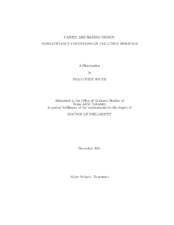| dc.description.abstract | This dissertation is about an open question of cartel ratifiable conditions. My research goal is to establish a mechanism which is able to detect and explain cartels' activities.
My research question in the second chapter is whether or not an efficient cartel mechanism is ratifiable in the first-price sealed-bid auction format with participation costs. R. McAfee and J. McMillan study the coordinated bidding strategies in a strong cartel, which is incentive-compatible and efficient. This chapter investigates this efficient collusive mechanism with two important conditions (1) bidders can update their information through a cartel's prior auction and (2) they have to pay participation costs to participate in seller's auction. The concept of ratifiability, introduced by P. Cramton and T. Palfrey, is applied to explore the first-price sealedbid auction with participation costs. I discovered that the efficient cartel mechanism, such as pre-auction knockout, would be ratified when either of the two conditions exists. However, this mechanism is no longer ratifiable when both conditions exist. The bidder with the highest value in the cartel would have incentive to betray, since doing so sends a credible signal of high value. Hence, the other bidders will be discouraged from participating in the seller's auction and the highest-value bidder maximizes his
revenue.
In the third chapter, I studied the seller's strategy when she faces a cartel in an auction mechanism. An active seller's optimal strategy is to raise the reserve price to a level that is higher than her own valuation. The collusive mechanism is sustainable even though its revenue is extracted by the higher reserve price. If the seller is authorized to change the auction mechanism, she can receive the expected payoff, prevent the formation of a ring and keep the auction efficient. Further, I presented two methods that could deter a cartel under specific conditions. One is the residual claimants method as proposed by Y. Che and J. Kim and the other is to set a positive participation cost as outlined in the first chapter. The residual claimants method can inhibit a ring in many cases, but it may have some trouble in preventing an efficient cartel mechanism when there is only one participant in the seller's auction.
In the fourth chapter, I investigated how to achieve external efficiency in a repeated game. In particular, I looked into the allocation of the budgeted that allows an authority, such as the government, to differentiate collusive behavior and to expose agents to external threats. A threshold level of the budget payment is found in an incentive compatible collusive mechanism for which the government can prevent an agent from participating. In a two-stage model, I showed that if the government can boost exemption or have more budget to subsidize agents, it is less likely that a ring will be formed. | en |


